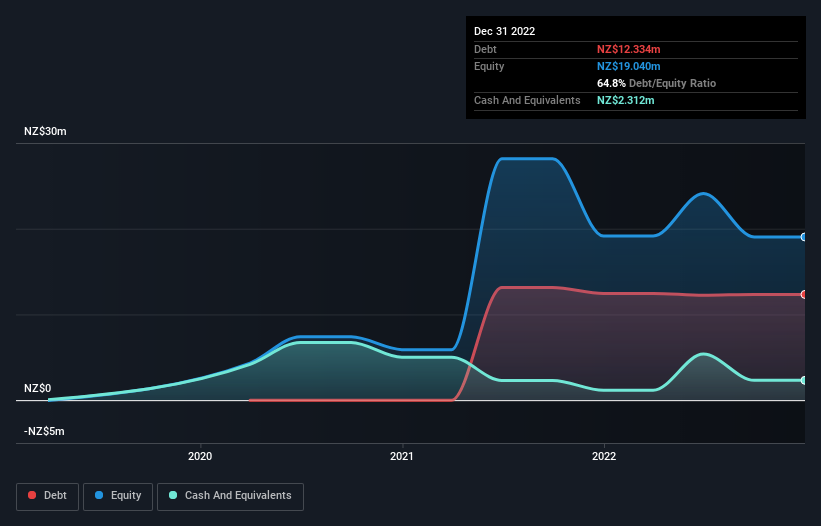
Legendary fund manager Li Lu (who Charlie Munger backed) once said, 'The biggest investment risk is not the volatility of prices, but whether you will suffer a permanent loss of capital.' When we think about how risky a company is, we always like to look at its use of debt, since debt overload can lead to ruin. We note that Me Today Limited (NZSE:MEE) does have debt on its balance sheet. But the more important question is: how much risk is that debt creating?
When Is Debt A Problem?
Debt assists a business until the business has trouble paying it off, either with new capital or with free cash flow. If things get really bad, the lenders can take control of the business. While that is not too common, we often do see indebted companies permanently diluting shareholders because lenders force them to raise capital at a distressed price. Of course, plenty of companies use debt to fund growth, without any negative consequences. When we examine debt levels, we first consider both cash and debt levels, together.
Check out our latest analysis for Me Today
How Much Debt Does Me Today Carry?
The chart below, which you can click on for greater detail, shows that Me Today had NZ$12.3m in debt in December 2022; about the same as the year before. However, because it has a cash reserve of NZ$2.31m, its net debt is less, at about NZ$10.0m.

How Healthy Is Me Today's Balance Sheet?
We can see from the most recent balance sheet that Me Today had liabilities of NZ$2.61m falling due within a year, and liabilities of NZ$12.3m due beyond that. On the other hand, it had cash of NZ$2.31m and NZ$2.47m worth of receivables due within a year. So its liabilities total NZ$10.1m more than the combination of its cash and short-term receivables.
This is a mountain of leverage relative to its market capitalization of NZ$16.8m. This suggests shareholders would be heavily diluted if the company needed to shore up its balance sheet in a hurry. When analysing debt levels, the balance sheet is the obvious place to start. But you can't view debt in total isolation; since Me Today will need earnings to service that debt. So if you're keen to discover more about its earnings, it might be worth checking out this graph of its long term earnings trend.
In the last year Me Today wasn't profitable at an EBIT level, but managed to grow its revenue by 27%, to NZ$6.6m. Shareholders probably have their fingers crossed that it can grow its way to profits.
Caveat Emptor
Despite the top line growth, Me Today still had an earnings before interest and tax (EBIT) loss over the last year. Its EBIT loss was a whopping NZ$8.7m. Considering that alongside the liabilities mentioned above does not give us much confidence that company should be using so much debt. Quite frankly we think the balance sheet is far from match-fit, although it could be improved with time. However, it doesn't help that it burned through NZ$7.9m of cash over the last year. So in short it's a really risky stock. There's no doubt that we learn most about debt from the balance sheet. But ultimately, every company can contain risks that exist outside of the balance sheet. Be aware that Me Today is showing 6 warning signs in our investment analysis , and 4 of those don't sit too well with us...
If, after all that, you're more interested in a fast growing company with a rock-solid balance sheet, then check out our list of net cash growth stocks without delay.
New: Manage All Your Stock Portfolios in One Place
We've created the ultimate portfolio companion for stock investors, and it's free.
• Connect an unlimited number of Portfolios and see your total in one currency
• Be alerted to new Warning Signs or Risks via email or mobile
• Track the Fair Value of your stocks
Have feedback on this article? Concerned about the content? Get in touch with us directly. Alternatively, email editorial-team (at) simplywallst.com.
This article by Simply Wall St is general in nature. We provide commentary based on historical data and analyst forecasts only using an unbiased methodology and our articles are not intended to be financial advice. It does not constitute a recommendation to buy or sell any stock, and does not take account of your objectives, or your financial situation. We aim to bring you long-term focused analysis driven by fundamental data. Note that our analysis may not factor in the latest price-sensitive company announcements or qualitative material. Simply Wall St has no position in any stocks mentioned.
About NZSE:MEE
Me Today
Through its subsidiaries, engages in the production, sale, and marketing of health and wellbeing products in New Zealand, the United States, and Europe.
Slight and slightly overvalued.
Market Insights
Community Narratives



